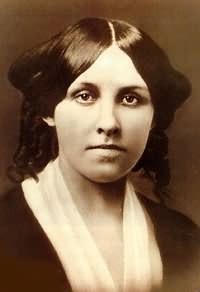
Louisa May Alcott biography
Louisa May Alcott (1832–1888)
Louisa May Alcott was an American poet and novelist known above all for the novels Little Women (1869) and Good Wives (1869) about the childhood and adolescence of four sisters, based on her own childhood experience. The novels have been reissued many times and have become classics of books for children and adolescents, they are still very popular. Theatre plays and motion pictures were staged, basing on the motives of these works. The name of the writer and her work have become well-known brands that are still used, for example, for dolls’ names.
Born in 1832 in Germantown (modern-day Philadelphia, Pennsylvania), Louisa May Alcott was the second of four daughters of transcendentalist Amos Bronson Alcott and the suffragette Abby May. When Louisa was two years old, the family moved to Boston, where Amos Bronson Alcott founded an experimental school and joined the Transcendental Club led by Ralph Waldo Emerson and Henry David Thoreau.
After several setbacks with the school, the Alcott’s moved to Concord, Massachusetts, where they joined the Utopian Fruitlands community, founded by the transcendentalists. Louisa was educated under the guidance of her father. His friends also played crucial role in her life. Among them were Emerson, Thoreau, Nathaniel Hawthorne, Margaret Fuller. She described this experience in the essay Transcendental Wild Oats, which was reprinted in the book Silver Pitchers (1876), dedicated to the time spent by Alcott at Fruitlands.
As a grown woman, Louisa Alcott became a follower of abolitionism and feminism. Because of the poverty of the family, she started working early (she was a governess, teacher, seamstress). Since childhood, she was fond of literature, wrote short stories and tales, plays for home theater. At 22, Louisa produced her first book, Flower Fables, which included stories written for Ellen Emerson, the daughter of Ralph Waldo Emerson. During the Civil War, she served as a nurse in a military hospital in Georgetown. In 1863, letters, which she wrote to her relatives, were revised and published as Hospital Sketches. This publication brought her first, though not very wide, recognition.
In 1868, the most famous and popular book of Alcott, Little Women, was published. The plot of this book is based on the life of the four daughters of the March family: Meg, Jo, Beth and Amy. It was created at the request of Boston publisher Thomas Niles, who asked Alcott to write a “book for girls.” The prototype of Meg was her older sister Anna, she expressed herself in the image of Jo, and the images of Beth and Amy were based on her younger sisters Elizabeth and May respectively.
The success of the book encouraged the writer to compose several related novels: in 1869 there was a sequel called Good Wives, which is often published together with the first part of the novel and tells of the youth of the March Sisters and their marriage; in 1871 was published the book Little Men, also semi-autobiographical, narrating about the nephews of the writer. The book describes a private school for boys. The rules of conduct there are rather free, but pupils, so different in nature and outlook on life, are imperceptibly becoming real men. Finally, in 1886 the book Jo’s Boys was published. In addition, many of the subsequent stories and tales of Alcott echoed the Little Women.
Unlike Joe March, her literary incarnation, Louisa May Alcott was never married. In 1879, after the death of her sister May, the writer took up her two-year-old niece Louisa May (she was named after her aunt and even received the same family nickname – Lulu).
Later Alcott became an active fighter for women’s rights and was the first woman to register for the elections in Concord, Massachusetts. Dominic Montserrat believes that Louisa May Alcott was the first to apply a fully formed story about the “curse of the mummy” in the story Lost in the Pyramid, or Curse of the Mummy (1869). The story was forgotten and attention was drawn to it in the late 1990s.
The last years of Alcott’s life were overshadowed by a painful illness. The death of his mother, and a few years later, her father, with whom Louise was bound by a particularly kind relationship, was really hard for her. Despite the deteriorating health, Alcott continued to write until her death. She died in Boston on March 6, 1888, from the effects of prolonged mercury poisoning (due to typhoid fever, she took calomel for a long time). The crater on Venus is named in honor of Louisa Alcott.





